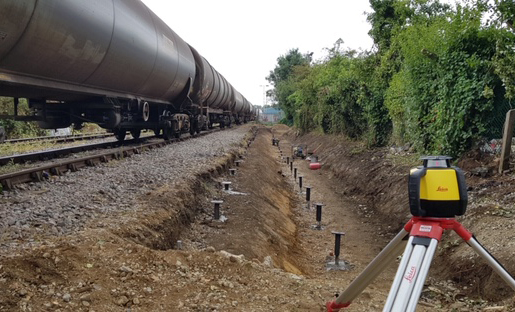 Consistently one of the busiest airports in the world, London Heathrow Airport consumes over 22 million liters (5.8 million gallons) of jet fuel per day, which is more than half of the amount used by the rest of the airports in the United Kingdom.1
Consistently one of the busiest airports in the world, London Heathrow Airport consumes over 22 million liters (5.8 million gallons) of jet fuel per day, which is more than half of the amount used by the rest of the airports in the United Kingdom.1
Roughly 20% of the airport’s jet fuel is delivered by rail2 and plans were made to increase that amount. A 100-meter-long (328 feet) extension of the aviation fuel railway terminal at Heathrow Airport would allow for a two-fold increase in the amount of fuel that could be delivered by rail.
 In order to extend the rail fuel terminal platform, solutions to overcome undesirable building conditions first had to be determined. A high water table of 1.5 meters (5 feet) below ground level and otherwise poor ground conditions did not make a traditional concrete foundation a viable option.
In order to extend the rail fuel terminal platform, solutions to overcome undesirable building conditions first had to be determined. A high water table of 1.5 meters (5 feet) below ground level and otherwise poor ground conditions did not make a traditional concrete foundation a viable option.
Additionally, because of the need to complete the project on a precise timetable, with only two days available between rail deliveries, a foundation solution was required that could be installed quickly and offer a predictable high capacity.
Dyer & Butler Ltd., a civil engineering company specializing in airport and rail projects, was selected to take on the complex project. Working with screw pile experts at Ground Sun UK, Chance® Helical Pulldown™ Micropiles were selected as the best foundation solution for the complex project.
HeliCAP® helical capacity design software was used to design the Helical Pulldown Micropiles, giving engineers needed information about product selection, installation depth, and capacity.
A high capacity system, Helical Pulldown Micropiles combine the end-bearing design of a standard helical pile and adds a grout column for side resistance which is ideal for sites that have weak soil and limited access, like the conditions at the Heathrow rail terminal.
Engineers designed the foundation requiring 80 piles, SS5 with 8/10/12 3-helix lead sections. They were installed at various depths up to 12 meters (40 feet). Installation torque of 7,500 Nm (5,500 lb-ft) was required during installation to reach an ultimate capacity of up to 280 kN (63 kip). Using a DP-1 Differential Pressure Torque Indicator and the data provided from HeliCAP, installation crews could measure torque during installation and be confident that the required ultimate capacity was achieved.
“The project was a perfect fit for the Chance Helical Pulldown Micropile: narrow access next to a railway, weak soils together with a high water table (1.5m) and all site work restricted in between train deliveries,” said Niall Connell of Ground Sun. “With 80 piles installed in 2 days, the Main contractor was very pleased to see the speed of installation and delighted the piles could be loaded instantly allowing the concrete form work to begin straight away as each pile was installed.”
The platform extension was successfully completed in time for the next fuel delivery. The line, carrying the heaviest payload of all rail lines in the United Kingdom, is now better equipped to serve the Airport and its immense fuel needs.
1 Why do Planes use Kerosene? https://www.rix.co.uk/blog, January 4, 2021.
2 Freight trains fuel up London Heathrow, https://www.railfreight.com/railfreight/2019/10/03/trains-supply-fuel-to-london-heathrow-airport/, March 10, 2019.

